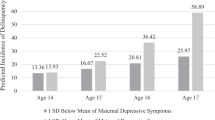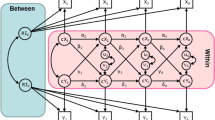Abstract
Little is known about the ways in which the accumulation of maternal factors increases or reduces risk for girls’ disruptive behavior during preadolescence. In the current study, maternal risk and promotive factors and the severity of girls’ disruptive behavior were assessed annually among girls’ ages 7–12 in an urban community sample (N = 2043). Maternal risk and promotive factors were operative at different time points in girls’ development. Maternal warmth explained variance in girls’ disruptive behavior, even after controlling for maternal risk factors and relevant child and neighborhood factors. In addition, findings supported the cumulative hypothesis that the number of risk factors increased the chance on girls’ disruptive behavior disorder (DBD), while the number of promotive factors decreased this probability. Daughters of mothers with a history of Conduct Disorder (CD) were exposed to more risk factors and fewer promotive factors compared to daughters of mothers without prior CD. The identification of malleable maternal factors that can serve as targets for intervention has important implications for intergenerational intervention. Cumulative effects show that the focus of prevention efforts should not be on single factors, but on multiple factors associated with girls’ disruptive behavior.


Similar content being viewed by others
References
American Psychiatric Association. (1994). Diagnostic and statistical manual of mental disorders (4th ed.). Washington: Author.
Appleyard, K., Egeland, B., van Dulmen, M., & Sroufe, L. A. (2005). When more is not better: the role of cumulative risk in child behavior outcomes. Journal of Child Psychology and Psychiatry, 46, 235–245.
Babor, T. F., de la Fuente, J. R., Saunders, J., & Grant, M. (1992). Audit, the alcohol use disorders identification test: guidelines for use in primary health care. (WHO publication 92.4). Geneva: World Health Organization.
Beck, A. T., Steer, R. A., & Brown, G. K. (1996). BDI-II manual. San Antonio: The Psychological Corporation.
Blatt-Eisengart, I., Drabick, D. A. G., Monahan, K. C., & Steinberg, L. (2009). Sex differences in the longitudinal relations among family risk factors and childhood externalizing symptoms. Developmental Psychology, 45, 491–502.
Bongers, I. L., Koot, H. M., van der Ende, E. J., & Verhulst, F. C. (2003). The normative development of child and adolescent problem behavior. Journal of Abnormal Psychology, 112, 179–192.
Bornovalova, M. A., Hicks, B. M., Iacono, W. G., & McGue, M. (2010). Familial transmission and heritability of childhood disruptive disorders. The American Journal of Psychiatry, 167, 1066–1074.
Bowlby, J. (1951). Maternal care and mental health. World Health Organization Monograph.
Bronfenbrenner, U. (1979). The ecology of human development. Cambridge: Harvard University Press.
Caspi, A., & Moffitt, T. E. (1995). The continuity of maladaptive behavior: From description to understanding in the study of antisocial behavior. In D. Cicchetti & D. J. Cohen (Eds.), Developmental psychopathology, vol 2, Risk, disorder, and adaptation (pp. 472–511). New York: Wiley.
Deater-Deckard, K., Dodge, K. A., Bates, J. E., & Pettit, G. S. (1998). Multiple risk factors in the development of externalizing behavior problems: group and individual differences. Development and Psychopathology, 10, 469–483.
Eckenrode, J., Campa, M., Luckey, D. W., Henderson, C. R., Jr., Cole, R., Kitzman, H., & Olds, D. (2010). Long term effects of prenatal and infancy nurse home visitation on the life course of youths: 19-year follow-up of a randomized trial. Archives of Pediatrics & Adolescent Medicine, 164, 9–15.
Farrington, D. P., & Loeber, R. (2000). Some benefits of dichotomization in psychiatric and criminological research. Criminal Behavior and Mental Health, 10, 100–122.
Farrington, D. P., Loeber, R., Jolliffe, D., & Pardini, D. A. (2008). Promotive and risk processes at different life stages. In R. Loeber, D. P. Farrington, M. Stouthamer-Loeber, & H. R. White (Eds.), Violence and serious theft: Development and prediction from childhood to adulthood (pp. 241–310). New York: Routledge.
First, M. B., Spitzer, R. L., Gibbon, M., & Williams, J. (1996). Structured clinical interview for DSM-IV Axis I disorders. New York: Biometrics Research Department, New York State Psychiatric Institute.
Gadow, K., & Sprafkin, J. (1994). Child symptom inventories manual. Stoneybrook: Checkmate plus.
Hawkins, S. R., Graham, P. W., Williams, J., & Zahn, M. A. (2009). Resilient girls - factors that protect against delinquency (NCJ 220124). Washington: Office of Juvenile Justice and Delinquency Prevention.
Herndon, R. W., & Iacono, W. G. (2005). The familial transmission of antisocial behavior from parent to child. Psychological Medicine, 35, 1815–1824.
Hipwell, A. E., Loeber, R., Stouthamer-Loeber, M., Keenan, K., White, H. R., & Kroneman, L. (2002). Characteristics of girls with early onset disruptive and antisocial behaviour. Criminal Behaviour and Mental Health, 12, 99–118.
Keenan, K., & Stouthamer-Loeber, M. (2000). Pre- and Perinatal Risk Factors (PPRF). Unpublished Instrument, Pittsburgh Girls Study, University of Pittsburgh.
Keenan, K., Hipwell, A., Chung, T., Stepp, S., Stouthamer-Loeber, M., Loeber, R., & McTigue, K. (2010a). The Pittsburgh Girls Study: overview and initial findings. Journal of Clinical Child and Adolescent Psychology, 39, 506–521.
Keenan, K., Wroblewski, K., Hipwell, A. E., Loeber, R., & Stouthamer-Loeber, M. (2010b). Age of onset, symptom threshold, and expansion of the nosology of conduct disorder for girls. Journal of Abnormal Child Psychology, 119, 689–698.
Kerns, K. A., Siener, S., & Brumariu, L. E. (2011). Mother-child relationships, family context, and child characteristics as predictors of anxiety symptoms in middle childhood. Development and Psychopathology, 23, 593–604.
Kroneman, L., Loeber, R., Hipwell, A., & Koot, H. M. (2009). Girls’ disruptive behavior and its relationship to family functioning: a review. Journal of Child and Family Studies, 18, 259–273.
Loeber, R., & Stouthamer-Loeber, M. (1986). Family factors as correlates and predictors of juvenile conduct problems and delinquency. Crime and justice: An annual review of the research, 7, 29–150.
Loeber, R., Farrington, D. P., Stouthamer-Loeber, M., & Van Kammen, W. B. (1998). Multiple risk factors for multiproblem boys: cooccurrence of delinquency, substance use, attention deficit, conduct problems, physical aggression, covert behavior, depressed mood, and shy/withdrawn behavior. In R. Jessor (Ed.), New perspectives on adolescent risk behavior (pp. 90–149). Cambridge: Cambridge University Press.
Loeber, R., Slot, N. W., & Stouthamer-Loeber, M. (2006). A three-dimensional, cumulative developmental model of serious delinquency. In P. O. H. Wikström & R. J. Sampson (Eds.), The explanation of crime (pp. 153–194). Cambridge: Cambridge University Press.
Loeber, R., Pardini, D. A., Hipwell, A., Stouthamer-Loeber, M., Keenan, K., & Sembower, M. A. (2009). Are there stable factors in preadolescent girls’ externalizing behaviors? Journal of Abnormal Child Psychology, 37, 777–791.
Lösel, F., & Bender, D. (2003). Protective factors and resilience. In D. P. Farrington & J. W. Coid (Eds.), Early prevention of adult antisocial behavior (pp. 130–204). Cambridge: Cambridge University Press.
Luthar, S. S., Cicchetti, D., & Becker, B. (2000). The construct of resilience: a critical evaluation and guidelines for future work. Child Development, 71, 543–562.
Madigan, S., Moran, G., Schuengel, C., Pederson, D. R., & Otten, R. (2007). Unresolved maternal attachment representations, disrupted maternal behavior and disorganized attachment in infancy: links to toddler behavior problems. Journal of Child Psychology and Psychiatry, 48, 1042–1050.
Moffitt, T. E., Caspi, A., Rutter, M., & Silva, P. A. (2001). Sex differences in antisocial behavior. Cambridge: Cambridge University Press.
Olino, T. M., Seeley, J. R., & Lewihnson, P. M. (2010). Conduct disorder and psychosocial outcomes at age 30: early adult psychopathology as a potential mediator. Journal of Abnormal Child Psychology, 38, 1139–1149.
Pajer, K. A. (1998). What happens to “bad” girls? A review of the adult outcomes of antisocial adolescent girls. The American Journal of Psychiatry, 155, 862–870.
Patrick, M. R., Snyder, J., Schrepferman, L. M., & Snyder, J. (2005). The joint contribution of early parental warmth, communication and tracking, and early child conduct problems on monitoring in late childhood. Child Development, 76, 999–1014.
Patterson, G., Reid, J., & Dishion, T. (1992). Antisocial boys: a social interactional approach. Eugene: Castalia.
Petitclerc, A., & Tremblay, R. E. (2009). Childhood disruptive behaviour disorders: review of their origin, development, and prevention. Canadian Journal of Psychiatry, 54, 222–231.
Rutter, M. (1979). Protective factors in children’s responses to stress and disadvantage. In M. W. Kent & J. E. Rolf (Eds.), Primary prevention of psychopathology, volIII, Social competence in children (pp. 49–74). Hanover: University Press of New England.
Sameroff, A. J. (1998). Environmental risk factors in infancy. Paediatric, 102, 1287–1292.
Sameroff, A. J. (2000). Developmental systems and psychopathology. Development and Psychopathology, 12, 297–312.
Snyder, J., Cramer, A., Afrank, J., & Patterson, G. R. (2005). The contributions of ineffective discipline and parental hostile attributions of child misbehavior to the development of conduct problems at home and school. Developmental Psychology, 41, 30–41.
StataCorp. (2009). Stata statistical software: Release 11. College Station: StataCorp LP.
Stouthamer-Loeber, M., Loeber, R., Wei, E., Farrington, D. P., & Wikström, P. H. (2002). Risk and promotive effects in the explanation of persistent serious delinquency in boys. Journal of Consulting and Clinical Psychology, 70, 111–123.
Straus, M. A., Hamby, S. L., Finkelhor, D., Moore, D. W., & Runyan, D. (1998). Identification of child maltreatment with the Parent–child Conflict Tactics Scales: development and psychometric data for a national sample of American parents. Child Abuse & Neglect, 22, 249–270.
Tremblay, R. E. (2010). Developmental origins of disruptive behavior problems: the ‘original sin’ hypothesis, epigenetics and their consequences for prevention. Journal of Child Psychology and Psychiatry, 51, 341–367.
Twisk, J. W. R. (2003). Applied longitudinal data analysis for epidemiology. Cambridge: Cambridge University Press.
van den Oord, E. J., Verhulst, F. C., & Boomsma, D. I. (1996). A genetic study of maternal and paternal ratings of problem behaviors in 3-year-old twins. Journal of Abnormal Psychology, 105, 349–357.
van der Laan, A. M., Veenstra, R., Bogaerts, S., Verhulst, F. C., & Ormel, J. (2010). Serious, minor, and non-delinquents in early adolescence: the impact of cumulative risk and promotive factors. The TRAILS study. Journal of Abnormal Child Psychology, 38, 339–351.
Verhulst, F. C. (1995). Recent developments in the assessment and diagnosis of child psychopathology. European Journal of Psychological Assessment, 11, 203–212.
Wakschlag, L. S., Pickett, K. E., Kasza, K. E., & Loeber, R. (2006). Is prenatal smoking associated with a developmental pattern of conduct problems in young boys? Journal of the American Academy of Child and Adolescent Psychiatry, 45, 461–467.
Webster-Stratton, C. (1996). Early-onset conduct problems: does gender make a difference? Journal of Consulting and Clinical Psychology, 64, 540–551.
White, H. R., Hipwell, A., & Mizelle, K. (2002). Parent Substance Use Inventory (SUI). Unpublished Instrument, Pittsburgh Girls Study, University of Pittsburgh.
Zeger, S. L., & Liang, K. Y. (1986). Longitudinal data analysis for discrete and continuous outcomes. Biometrics, 42, 121–130.
Zoccolillo, M. (1993). Gender issues in conduct disorder. Development and Psychopathology, 5, 65–78.
Acknowledgments
This study was supported by grants from the National Institute of Mental Health (MH 56630, MH071790) and the National Institute on Drug Abuse (DA012237). In addition, it was supported by travel grants from the Leiden University Fund and the foundation ‘Stichting de Drie Lichten’. Point of views or opinions expressed in this article are those of the authors and do not necessarily reflect the views of the National Science Foundation.
Author information
Authors and Affiliations
Corresponding author
Rights and permissions
About this article
Cite this article
van der Molen, E., Hipwell, A.E., Vermeiren, R. et al. Cumulative Effects of Mothers’ Risk and Promotive Factors on Daughters’ Disruptive Behavior. J Abnorm Child Psychol 40, 727–739 (2012). https://doi.org/10.1007/s10802-011-9595-2
Published:
Issue Date:
DOI: https://doi.org/10.1007/s10802-011-9595-2




